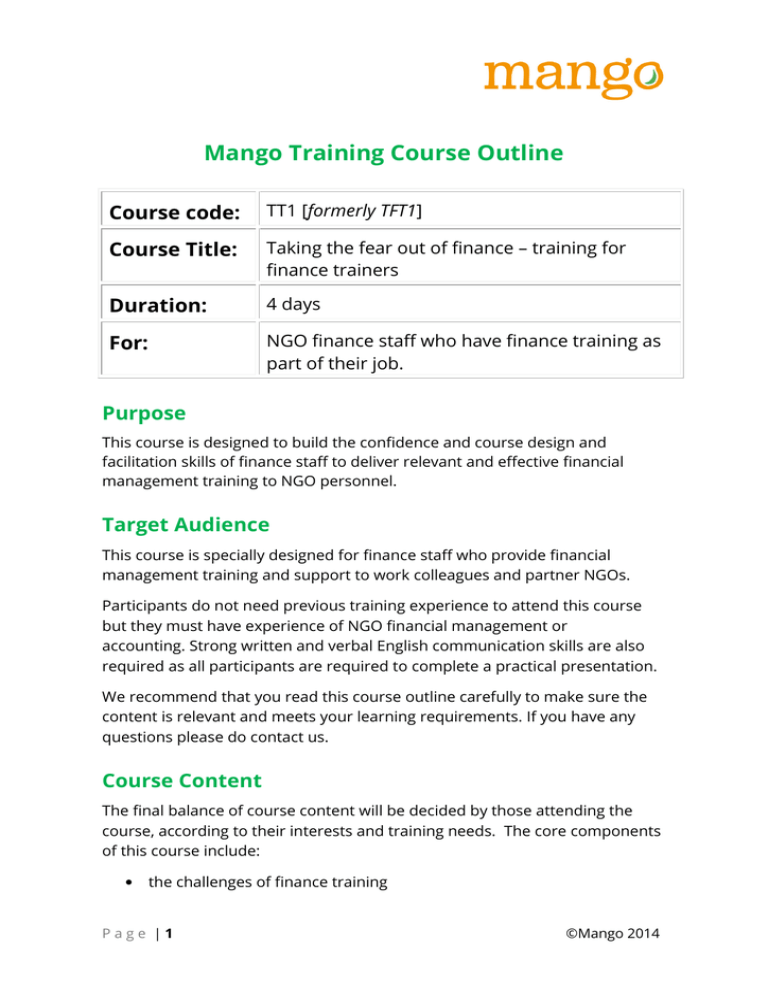Mango Training Course Outline
advertisement

Mango Training Course Outline Course code: TT1 [formerly TFT1] Course Title: Taking the fear out of finance – training for finance trainers Duration: 4 days For: NGO finance staff who have finance training as part of their job. Purpose This course is designed to build the confidence and course design and facilitation skills of finance staff to deliver relevant and effective financial management training to NGO personnel. Target Audience This course is specially designed for finance staff who provide financial management training and support to work colleagues and partner NGOs. Participants do not need previous training experience to attend this course but they must have experience of NGO financial management or accounting. Strong written and verbal English communication skills are also required as all participants are required to complete a practical presentation. We recommend that you read this course outline carefully to make sure the content is relevant and meets your learning requirements. If you have any questions please do contact us. Course Content The final balance of course content will be decided by those attending the course, according to their interests and training needs. The core components of this course include: • the challenges of finance training Page |1 ©Mango 2014 • how adults learn and what that means for trainers • course design basics: learning objectives, lesson plans, selection of approach • participatory training techniques and when to use them • how to make financial concepts and jargon interesting and clear • creating effective resource materials to support the learning • how to deal with things that go wrong in the training room. Also see below for the Programme Guide. Learning Outcomes At the end of the course, participants will be able to: Do: Know: Feel: Page |2 • Write ‘SMART’ learning objectives as part of the course design process for a finance training session • Create a session plan for a finance training session using the ‘CPR’ process • Create effective resource materials to support the learning • Demonstrate at least 15 different participatory training techniques that can be used in finance training • Deliver a participatory-style training session using plain language, to build financial skills and knowledge • Describe the key challenges facing finance trainers and how to overcome them • List the five key questions used in the course design framework • Describe how adults learn and why we should take this into account when designing a course • Outline strategies for dealing with challenging situations that arise during a training event • Appreciate the value of using plain language in finance training • Recognise that finance training doesn’t have to be boring and is more effective when a practical, participatory approach is used. ©Mango 2014 Training Approach Mango’s training approach is highly practical, participatory and often fun! We focus on real issues and help participants to use the techniques covered, rather than just discuss them. We work hard to de-mystify financial concepts to overcome the fear of finance. “Mango training really does take the fear out of finance!” We work with small groups to meet the needs of individual participants. We use a variety of learning methods to stimulate interest and meet differing learning styles of participants – including illustrated presentations, group exercises and discussions, case studies and practical problem-solving activities. Courses are supported by extensive materials for participants to take away and apply after the course. We also offer a free follow-up service by email or phone to all Mango trainees. How to Book This course is available as an open, in-house or group training event. Please visit our website to plan your training or contact the training team at training@mango.org.uk for more information. Page |3 ©Mango 2014 Taking the fear out of finance PROGRAMME GUIDE Day Module: Topics to be covered: Day 1 Welcome and Overview • Course Planning and Design • The challenges of finance training • Getting organised – the Training Process • A training needs model – Skills vs Confidence Introductions, expectations and programme overview Matrix • Course design frameworks – 5 Key Questions and CPR Day 2 Making your training effective • Practical: mind mapping a course design • Writing observable Learning Objectives • What we can learn from how adults learn • Participatory training in action • Session planning – identifying course content, activities and timing • Practical: Selection and design of participatory techniques Day 3 Communicating and supporting your message • Great flip charts, visual aids and handouts • Responding to the challenge of jargon – how to communicate technical terms and concepts • Giving clear instructions – or how to avoid unexpected results Day 4 Practice makes perfect! Page |4 • Don’t panic! Be prepared when things go wrong • Practical: preparing resource materials • Presentations by course participants • Summary and action planning • Evaluation, certificates & close ©Mango 2014


